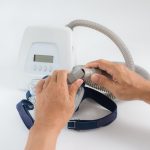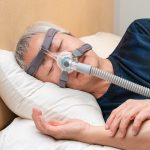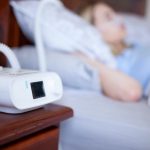The Physical Health Risks of Untreated Sleep Apnea
Posted by Dr. Michael Breus

The impact of sleep apnea on health and performance is both serious and wide-ranging. Sleep-disrupted breathing affects nearly every aspect of our waking lives. There are the daily functioning problems we can feel, including powerful fatigue and loss of energy, irritability and shifting mood, trouble with focus, forgetfulness, and restless, unsatisfying, unrefreshing sleep.
Most people with OSA experience some degree of these symptoms—but they often don’t know their struggles are the result of a sleep-disordered breathing condition. Maybe it’s age, maybe it’s stress, maybe it’s not eating right or getting enough exercise.
I can’t stress enough how important it is to talk with your doctor about these symptoms. As you’ll see, it could not only improve your daily functioning but protect your long-term health and extend your life.
That’s because in addition to the interference with daily functioning, untreated sleep apnea has a significant impact on underlying health. Left untreated, OSA contributes to a number of serious medical conditions, raising the risk for serious disease and premature death.
Here’s what you need to know about the physical health risks linked to sleep apnea.
OSA and cardiovascular disease
Sleep apnea puts significant stress on the heart, through a number of pathways.
- Sleep apnea reduces oxygen levels in the body. Compromised breathing during sleep lowers oxygen intake, forcing the heart to work harder to supply oxygen throughout the body – the heart rate goes up, and so does blood pressure.
- Sleep apnea triggers inflammation, elevating pro-inflammatory chemicals in the body. The root causes of OSA-related inflammation aren’t entirely clear to scientists. It may be the result of interrupted breathing and reduced oxygen, fragmented sleep, obesity, which is common (but not always present) in people with sleep apnea. What we do know is that inflammation hurts cardiovascular health and inflicts damage on the heart and vascular system.
- Sleep apnea restricts high-quality sleep. Lack of sound sleep is itself an important factor in cardiovascular disease risk. Both poor quality sleep and insufficient sleep are linked to a higher risk of heart disease. Sleep apnea’s episodes of interrupted breathing—dozens, sometimes hundreds a night—deprive people of the sound sleep they need to keep the heart healthy.
- Sleep apnea activates the ‘fight or flight’ nervous system. OSA creates hyperactivity in the sympathetic nervous system. That’s the body’s on-alert, “fight or flight” system, which keeps us aroused and poised to respond to threat. In this hyper-aroused state, the heart works harder. More time in “fight or flight” mode means less time in “rest and digest” mode, aka the parasympathetic nervous system. When the parasympathetic system is activated, heart rate remains at a resting level, stress and arousal decline, and the immune system regroups.
The particular cardiovascular risks linked to sleep apnea include:
High blood pressure
Hypertension is common among people with undiagnosed and untreated OSA. As many as 50% or more of people with sleep apnea have high blood pressure. Untreated sleep apnea is a leading cause of high blood pressure that doesn’t respond to treatment. Treating OSA, including with CPAP, can help reduce blood pressure. Blood pressure may also need independent treatment to be lowered to healthy levels.
Coronary artery disease
Among people with OSA, rates of heart disease are elevated compared to the general public because high blood pressure can eventually lead to heart disease. Untreated sleep apnea can launch a series of complications—first high blood pressure, then heart disease, which put people at higher risk for heart attack. For people who already have heart disease, the disrupted breathing and oxygen deprivation of sleep apnea can make their condition worse. Research shows that using CPAP to treat sleep apnea can reduce cardiac events in people with heart disease.
Stroke
Reduced oxygen supply in the blood, a consequence of sleep apnea, can lead to stroke. High blood pressure is major contributor to stroke risk, so sleep apnea can contribute indirectly to stroke by raising blood pressure. The more severe sleep apnea is, the higher the risk for stroke.
OSA and diabetes
Interrupted breathing, fragmented sleep, over-activity of the sympathetic nervous system, inflammation—these OSA-induced symptoms are all factors that impair the body’s ability to use insulin effectively. (Diabetes and OSA also share a common risk factor in obesity.) The hormone insulin transports glucose (aka sugar) from the bloodstream to cells, providing essential fuel and keeping blood sugar levels balanced. In prediabetes and type 2 diabetes, the body’s cells become resistant to insulin, causing the body to make more insulin to do the same job, of regulating blood sugar and feeding cells energy. Over time, the pancreas—where insulin is made—crashes, and stops being able to produce enough insulin. That’s the basic hormonal trajectory to diabetes.
Untreated OSA significantly raises risk for diabetes. Scientific studies estimate that 70-85% of people with diabetes have moderate to severe sleep apnea. Treating OSA with CPAP can reduce the risk of diabetes in people with OSA.
OSA and metabolic syndrome
Cardiovascular disease and diabetes are deeply interrelated. They often occur together, and they can exacerbate one another. They share a number of contributing factors. Poor sleep, sleep-disordered breathing, high blood pressure, high cholesterol, obesity, excess fat in the abdominal area—this cluster of related symptoms comprise what’s known as metabolic syndrome. Metabolic syndrome is a pre-cursor to both cardiovascular disease and diabetes. Research shows that people with OSA have high rates of metabolic syndrome, making them vulnerable to cardiovascular conditions and to diabetes.
OSA and dementia
The impact of sleep apnea on cognitive health and function can be both broad and severe. Fragmented sleep, reduced oxygen supply, inflammation all interfere with the ability of the brain to function normally and remain healthy. Untreated OSA:
- creates attention deficits
- interferes with memory and learning
- slows mental processing
- compromises verbal and spatial skills
- interferes with other “executive functions” including judgment, planning and decision making
The negative effects of sleep apnea on cognitive performance have been recognized for some time. More recently, scientists have discovered evidence of strong links between untreated sleep apnea and dementia. Studies have found that the sleep-disordered breathing of sleep apnea accelerates the build-up of damaging proteins that are key biomarkers for Alzheimer’s disease. And the lack of a full night’s sleep deprives the body of sufficient time to sweep away the accumulation of toxins, unhealthful proteins and other damaging biochemicals that compromise brain health. The body’s glymphatic system goes to work specifically during sleep to remove waste build up in the brain. This clearing out system does its most effective work during the deep stages of non-REM sleep. The fragmented sleep of OSA limits deep sleep, reducing the ability of the glymphatic system’s crucial work.
Other OSA-changes to sleep architecture put the brain at risk. REM sleep is important for processing memory and emotions, and for the plasticity of neural function. (That’s a fancy way of talking about our brain cells’ ability to create new connections and communicate effectively as we take in new information and experiences.) OSA suppresses REM sleep. And there’s evidence of a link between limited REM and the development of Alzheimer’s.
Some exciting recent research has shown that, in adults with mild cognitive impairment, treating OSA with CPAP can improve cognitive function.
OSA and cancer
We know less about the links between cancer and OSA than the other conditions I’ve discussed here. But there’s scientific evidence accumulating that sleep apnea, especially when severe, may be a factor in the development of some cancers. The interruptions to breathing that occur so frequently in severe OSA may raise mortality risks for cancer, may contribute to faster growing tumors, may increase risk for cancer metastasis, and may make cancer less responsive to treatment, according to new research.
OSA, accident and injury
Excessive daytime tiredness and fatigue are hallmark symptoms of sleep apnea. They’re the most likely symptoms for people to notice. In many cases, the snoring and gasping and awakenings that happen during sleep aren’t symptoms that people with sleep apnea are aware of. (Bed partners are more likely to notice these symptoms, as their own sleep is disrupted by the noise and restlessness of the person next to them.)
Daytime tiredness and fatigue compromises attention, focus, and vigilance. That puts people with sleep apnea at a significantly higher risk for accidents and injuries in a range of circumstances.
Sleep apnea increases risks of workplace accidents and injuries. A recent Canadian study found that people with sleep apnea are 2-3 times as likely to suffering injuries while on the job. That aligns with a body of research showing a twofold increase in occupational injury risk among people with sleep apnea. While it’s important for anyone with symptoms and risk factors to be screened for sleep apnea, it is crucial for people in safety-sensitive jobs. Treating sleep apnea with CPAP has been shown to lower risks for workplace accidents and injuries.
Sleep apnea significantly elevates risk for driving accidents. Drowsy driving is as dangerous as drunk driving. People with OSA are chronically tired, and at significantly higher risk for motor vehicle accidents. A 2018 study found people with OSA are nearly 2.5 times as likely to be drivers involved in motor vehicle accidents. The good news here? Treating sleep apnea with CPAP reduces that risk dramatically, up to 70% for people who use CPAP for at least 4 hours a night.
OSA and risk of early death
This constellation of serious and chronic health conditions linked to OSA raise mortality risks for people with this sleep disorder. A 2016 review of research found all-cause and cardiovascular mortality risks significantly elevated among people with sleep apnea. Both all-cause mortality and cardiovascular mortality risks can be reduced with use of CPAP, this same research determined. This is a lot of information to take in, and I know it can be scary stuff to hear. The risks are real—but so is the relief, and protection for short and long-term health that comes with diagnosis and treatment for sleep apnea. Untreated sleep apnea is dangerous. Sleep apnea treatment saves lives and restores healthy, vital, energetic functioning, for body and mind.
Sweet Dreams,
Michael J. Breus, PhD, DABSM
The Sleep Doctor™
www.thesleepdoctor.com












